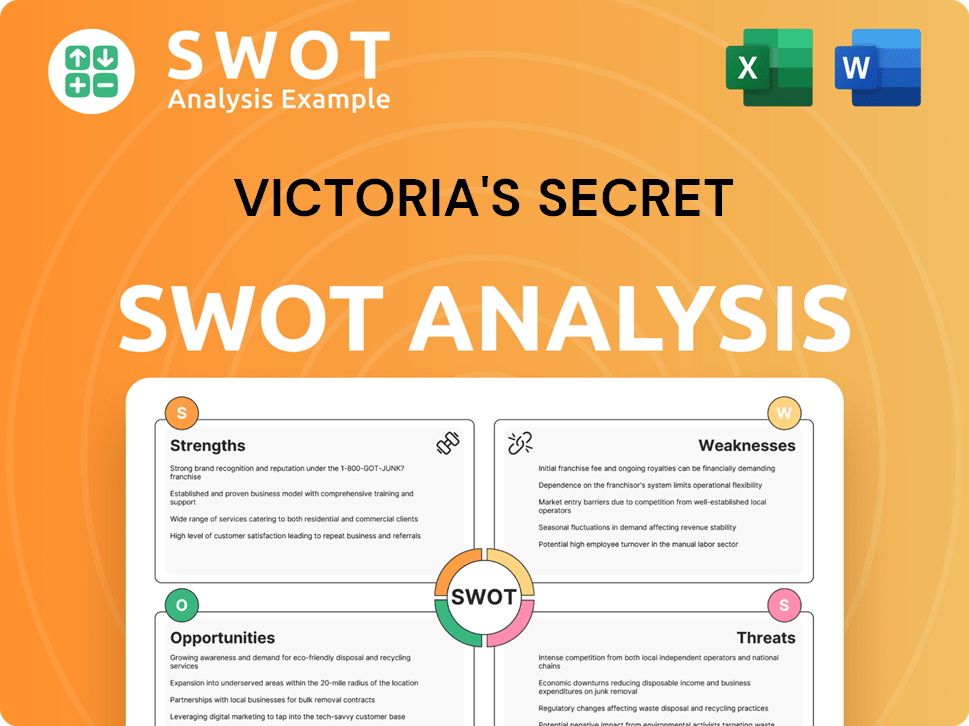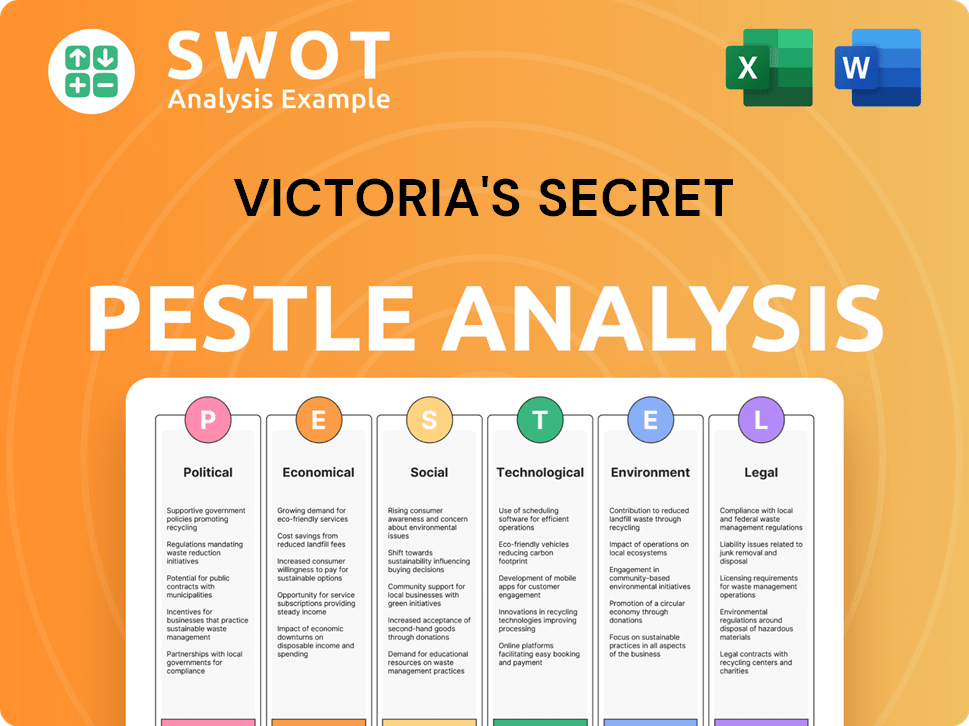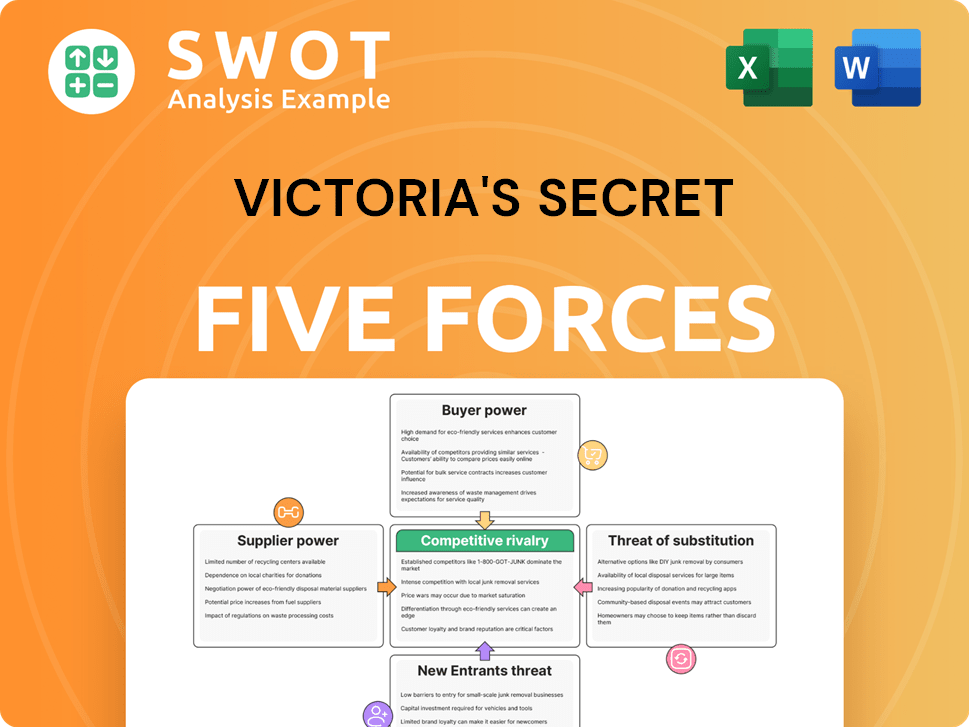Victoria's Secret Bundle
Can Victoria's Secret Reclaim Its Throne?
Victoria's Secret, once a titan of the lingerie industry, now faces a fiercely competitive landscape. The company's journey, marked by both triumphs and recent challenges, demands a deep dive into its rivals and strategic positioning. Understanding the Victoria's Secret SWOT Analysis is crucial to assess its strengths and weaknesses in this evolving market.

This exploration of the Victoria's Secret competitive landscape will dissect the key players in the lingerie industry, analyzing their strategies and impact on VS market analysis. We'll examine how Victoria's Secret competitors are vying for market share, considering retail market trends and the brand positioning strategies employed by each. Ultimately, this analysis aims to provide actionable insights into Victoria's Secret's future in a dynamic and competitive retail environment.
Where Does Victoria's Secret’ Stand in the Current Market?
Victoria's Secret & Co. holds a significant position in the intimate apparel and beauty industry, though its market dominance faces increasing pressure. The company operates through a broad network of stores, websites, and franchise partners globally, with a strong presence in North America. Its core product lines include bras, panties, lingerie, sleepwear, and fragrances, targeting a wide consumer base.
The brand has historically cultivated a premium image, but it's currently undergoing a transformation. This includes a digital transformation and diversification of offerings to appeal to a broader customer base. The company's strategic shifts reflect the evolving consumer preferences for inclusivity, comfort, and diverse sizing options within the lingerie industry.
For the fiscal year 2023, Victoria's Secret & Co. reported net sales of $6.181 billion. This financial performance underscores its substantial scale, despite facing challenges such as declining sales compared to previous years. The company's market share analysis shows its strong presence in North America, but it faces growing competition and challenges in maintaining its historical market share globally.
Victoria's Secret's market share in the lingerie segment, while significant, is under pressure from competitors. The company's revenue of $6.181 billion in 2023 reflects its substantial size within the retail market trends. However, this figure also indicates a decline compared to earlier years, highlighting the challenges it faces.
The company's distribution network spans company-owned stores, websites, and franchise partners across numerous countries. Its strong foothold in North America is a key aspect of its brand positioning. International expansion is a strategic focus, but it also brings increased competitive pressure.
Victoria's Secret is adapting its brand image to align with evolving consumer preferences. This includes a shift towards inclusivity, comfort, and diverse sizing. The target audience competition is also changing, requiring the brand to broaden its appeal to maintain relevance.
The competitive landscape includes direct-to-consumer (DTC) brands and diverse product offerings from competitors. Victoria's Secret's biggest challenges involve maintaining market share and adapting to changing consumer demands. The rise of online vs. brick and mortar lingerie stores competition is also a significant factor.
The lingerie industry faces constant shifts in consumer preferences and technological advancements. The competitive advantages of Victoria's Secret are being tested by new entrants and changing market dynamics. The impact of changing consumer preferences on Victoria's Secret is significant, driving the need for continuous innovation.
- The company's revenue of $6.181 billion in 2023 reflects its substantial scale.
- Victoria's Secret's market share analysis shows a strong presence in North America.
- The brand is undergoing a transformation to align with evolving consumer preferences.
- The competitive landscape includes DTC brands and diverse product offerings.
For further insights into the company's strategies, explore the Marketing Strategy of Victoria's Secret.
Victoria's Secret SWOT Analysis
- Complete SWOT Breakdown
- Fully Customizable
- Editable in Excel & Word
- Professional Formatting
- Investor-Ready Format

Who Are the Main Competitors Challenging Victoria's Secret?
Analyzing the Victoria's Secret competitive landscape reveals a complex market environment. The brand faces competition from a variety of sources, including direct rivals in the intimate apparel sector, broader retail competitors, and players in the beauty and personal care industries. Understanding these competitors is vital for assessing VS market analysis and its future prospects.
The lingerie industry is dynamic, with shifting consumer preferences and the rise of new business models. Brand positioning, product innovation, and marketing strategies are key factors in this competitive arena. The company must continuously adapt to maintain its market share and relevance.
Direct competitors include well-established brands. These brands compete directly with the company in the intimate apparel market, offering similar products and targeting similar customer segments.
Aerie has gained significant traction, especially among younger demographics. It focuses on body positivity and comfort, often outperforming the company in growth. Recent data shows Aerie's revenue growth has been consistently strong, reflecting its appeal to a broader customer base.
ThirdLove is a digitally native brand that uses e-commerce and personalized fitting experiences. It offers a wide range of sizes and styles. Its online presence and direct-to-consumer model provide a competitive edge.
Lively competes by focusing on comfort and a modern aesthetic. The brand's approach to marketing and product design resonates with contemporary consumers. Wacoal America's backing provides a strategic advantage.
Adore Me, owned by Savage X Fenty, is a digitally native brand that leverages e-commerce and personalized fitting experiences. It offers a wide range of sizes and styles, and is backed by the brand.
Indirect competitors include broader apparel retailers and beauty brands. These competitors offer alternative products or services that cater to similar consumer needs.
The retail market trends show that the company also faces competition from broader apparel retailers, such as Target and Amazon, which offer affordable options. The beauty and personal care segments present additional competition from mass-market and luxury brands. Celebrity-backed brands, like Savage X Fenty, have also disrupted the market. The company must consider these factors to stay competitive, as highlighted in an article about the Target Market of Victoria's Secret.
Several factors shape the competitive landscape. These include product innovation, inclusive sizing, and marketing campaigns. The rise of direct-to-consumer brands and the impact of mergers and acquisitions are also important.
- Product Innovation: Continuous development of new products and features is vital.
- Inclusive Sizing: Offering a wide range of sizes to cater to diverse body types.
- Marketing Campaigns: Effective marketing that resonates with modern consumers.
- Direct-to-Consumer Models: Leveraging e-commerce to reach customers directly.
- Mergers and Acquisitions: Strategic moves that reshape market power.
Victoria's Secret PESTLE Analysis
- Covers All 6 PESTLE Categories
- No Research Needed – Save Hours of Work
- Built by Experts, Trusted by Consultants
- Instant Download, Ready to Use
- 100% Editable, Fully Customizable

What Gives Victoria's Secret a Competitive Edge Over Its Rivals?
The competitive landscape for Victoria's Secret, a key player in the lingerie industry, has evolved significantly. Historically, the company's competitive advantages stemmed from its strong brand recognition and extensive retail presence. However, shifts in consumer preferences and the rise of new competitors have necessitated strategic adjustments to maintain its market position. Understanding the Victoria's Secret competitive landscape involves analyzing its core strengths, weaknesses, and the strategies it employs to compete in a dynamic retail market.
VS market analysis reveals a brand undergoing transformation. The company has been working to adapt its brand image, supply chain, and digital presence to meet changing consumer demands. This includes a focus on inclusivity and diversity, as well as investments in e-commerce and product innovation. The success of these efforts is crucial for navigating the competitive pressures within the lingerie industry.
The company's ability to adapt its brand image and product offerings is essential for its long-term success. The Victoria's Secret competitors are also evolving, with many focusing on similar strategies. The company's future depends on its capacity to innovate, adapt, and effectively leverage its omnichannel presence.
For years, the brand enjoyed strong customer loyalty due to its aspirational image. This recognition provided a significant advantage over newer entrants. However, the brand's image has been undergoing a refresh to be more inclusive and diverse.
The company's vast retail footprint, including numerous physical stores worldwide, offered accessibility and brand visibility. This allowed customers to experience products firsthand. The company is also enhancing its e-commerce capabilities to strengthen its digital presence.
The company leverages its established supply chain for competitive pricing and efficient product delivery. This includes manufacturing and distribution efficiencies. The company's supply chain is a key factor in its ability to compete effectively.
Investing in e-commerce and integrating online and offline shopping experiences is a priority. Product innovation, particularly in comfort and fit, is also crucial. These efforts aim to meet changing consumer preferences and stay competitive.
The company faces challenges in a rapidly changing retail landscape. Its ability to adapt its brand image, innovate product offerings, and leverage its omnichannel presence will determine its future success. The company has been working to address these challenges through various strategic initiatives.
- Brand Refresh: Focusing on inclusivity and diversity to broaden appeal.
- Product Innovation: Prioritizing comfort and fit to meet evolving consumer demands.
- Digital Transformation: Enhancing e-commerce and integrating online and offline experiences.
- Supply Chain Optimization: Maintaining efficient manufacturing and distribution processes.
For further insights into the company's strategic moves, consider reading about the Growth Strategy of Victoria's Secret. The company's future hinges on its ability to adapt to the evolving retail market trends and maintain a competitive edge in the lingerie industry.
Victoria's Secret Business Model Canvas
- Complete 9-Block Business Model Canvas
- Effortlessly Communicate Your Business Strategy
- Investor-Ready BMC Format
- 100% Editable and Customizable
- Clear and Structured Layout

What Industry Trends Are Reshaping Victoria's Secret’s Competitive Landscape?
The Victoria's Secret competitive landscape is currently navigating a dynamic period, influenced by shifting consumer preferences and technological advancements. The intimate apparel and beauty sector is experiencing significant changes, with a growing emphasis on inclusivity, sustainability, and digital integration. This creates both challenges and opportunities for brands like Victoria's Secret, shaping its market position and future outlook.
Understanding the VS market analysis requires considering both internal strategies and external factors. The brand faces competition from various players within the lingerie industry, including established retailers and digitally native brands. Analyzing these elements is crucial for assessing Victoria's Secret's ability to adapt and thrive in a competitive environment, influenced by evolving retail market trends.
The intimate apparel sector is seeing increased demand for inclusivity, comfort, and sustainability. Consumers are looking for brands that offer diverse sizing options, cater to various body types, and use eco-friendly materials. This trend necessitates that brands adapt their product offerings and marketing strategies to meet evolving consumer preferences.
Competition from agile, digitally native brands and maintaining brand relevance are key challenges. Economic downturns impacting discretionary spending also pose a risk. Regulatory changes related to product safety and environmental impact could further influence manufacturing and sourcing strategies.
Significant growth opportunities exist in emerging markets with rising disposable incomes. Product innovation in sustainable materials and adaptive designs presents avenues for differentiation. Strategic partnerships could also unlock new customer segments and enhance product offerings.
Victoria's Secret is focusing on brand revitalization, digital acceleration, and product diversification. The company aims to align with contemporary consumer values and leverage its global scale to regain market leadership. These strategies are crucial for adapting to the competitive landscape.
To assess the Victoria's Secret competitive landscape, it's essential to understand the strategic moves of its rivals and the brand's responses. This includes evaluating how Victoria's Secret competitors are positioned in the market and what strategies they are employing.
- Brand Positioning: The brand is working to redefine its image to appeal to a broader audience, moving away from its historical focus.
- Digital Transformation: Investments in e-commerce and data analytics are crucial for personalizing shopping experiences and enhancing direct-to-consumer models.
- Product Diversification: Expanding product lines to include sustainable materials and inclusive sizing is a key strategy.
- Market Expansion: Exploring growth opportunities in emerging markets is a priority.
Victoria's Secret Porter's Five Forces Analysis
- Covers All 5 Competitive Forces in Detail
- Structured for Consultants, Students, and Founders
- 100% Editable in Microsoft Word & Excel
- Instant Digital Download – Use Immediately
- Compatible with Mac & PC – Fully Unlocked

Related Blogs
- What are Mission Vision & Core Values of Victoria's Secret Company?
- What is Growth Strategy and Future Prospects of Victoria's Secret Company?
- How Does Victoria's Secret Company Work?
- What is Sales and Marketing Strategy of Victoria's Secret Company?
- What is Brief History of Victoria's Secret Company?
- Who Owns Victoria's Secret Company?
- What is Customer Demographics and Target Market of Victoria's Secret Company?
Disclaimer
All information, articles, and product details provided on this website are for general informational and educational purposes only. We do not claim any ownership over, nor do we intend to infringe upon, any trademarks, copyrights, logos, brand names, or other intellectual property mentioned or depicted on this site. Such intellectual property remains the property of its respective owners, and any references here are made solely for identification or informational purposes, without implying any affiliation, endorsement, or partnership.
We make no representations or warranties, express or implied, regarding the accuracy, completeness, or suitability of any content or products presented. Nothing on this website should be construed as legal, tax, investment, financial, medical, or other professional advice. In addition, no part of this site—including articles or product references—constitutes a solicitation, recommendation, endorsement, advertisement, or offer to buy or sell any securities, franchises, or other financial instruments, particularly in jurisdictions where such activity would be unlawful.
All content is of a general nature and may not address the specific circumstances of any individual or entity. It is not a substitute for professional advice or services. Any actions you take based on the information provided here are strictly at your own risk. You accept full responsibility for any decisions or outcomes arising from your use of this website and agree to release us from any liability in connection with your use of, or reliance upon, the content or products found herein.